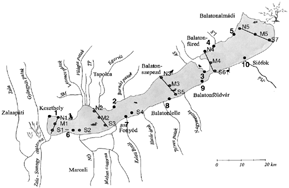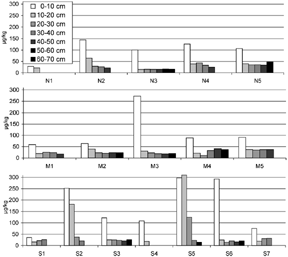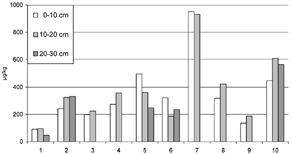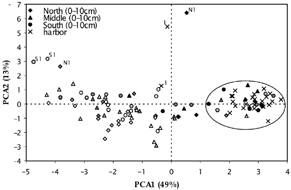Abstract
The determination of 13 PAH pollutants was carried out on sediment samples collected at 27 sites at the Lake Balaton, Hungary. The aim was to investigate the distribution patterns of PAHs and the correlation of source-sink relationship. Sediment samples were collected from the upper 10 cm and from 20 to 70 cm depth. The dry mass ratio of the fine grain-size fraction (<0.063 mm) and the coarse sand sediments (0.063–500 mm) were analyzed. Principal component analysis (PCA) was performed on the PAH compositional data for 110 samples to estimate the distribution of PAHs in different compartments. The average concentration of PAHs was found as 132 μg/kg dry weight (11–1734 μg/kg) for all sites and depth. Considering the harbors, at some sites, 930–950 μg/kg of total PAHs were obtained. The ratio of phenantrene/anthracene (PHE/AN) and fluoranthene/pyrene (FA/PY) indicated that most of the samples showed pyrogenic origin. It can be established that the upper 10 cm of the sediment is significantly more polluted than the deeper layers. The interim sediment quality guideline (ISQG) values and the probable effect level (PEL) were used to compare our findings with other data. No concentrations of PAHs were found higher than either ISQG and PEL values of samples collected inside of the lake, so the sediment has not been associated with adverse biological effects. However, the maximum concentrations of 7 out of 9 PAH compounds found in samples of harbors were higher than ISOG values but lower than PELs. Analysis of the harbor sediments revealed an elevated amount of contamination probably derived from the fuel of ships.
Biomass and fossil fuel burning is one of the most important sources of primary organic particles globally. Most of the work in identifying compounds originating from biomass burning sources has concentrated on polycyclic aromatic hydrocarbons (PAHs), which are toxic. The concentrations and size of PAH molecules emitted in burning episodes depends highly on the efficiency of burning, and does not seem to be affected by the type of plant being burned (Citation1). Forest fires and volcanoes also contribute to the PAH burden, and residential heating, coke production, incineration, and internal combustion engines are other major sources of PAHs. Since the compounds associated with the particles may remain in the atmosphere for several days, PAHs can be used as tracers of anthropogenic activity. PAHs are transported in the atmosphere as gas and/or particulate phases and scavenged according to various processes: (Citation1) wet deposition, PAHs become associated with rain either by being dissolved in the raindrop or being incorporated as particles; (Citation2) dry deposition, they are associated with particles, whose transport is complex, depending on various physical factors; (Citation3) air-water exchange, they may be adsorbed when facing large aquatic systems.
PAH compounds in the natural waters can be accumulated in the sediments due to its low volatility. From the upper part of the sediment, either they can be removed by the uptake of plants or microorganism, or they can penetrate into deeper sediments. It is already proved that several species of algae and microorganism are able to decompose the PAHs, primarily the small-molecular-weight compounds from the upper part of the sediment (Citation2). Investigations mostly focused on the distribution and fate of the PAH-contaminated river, lake, and harbor sediments (Citation3–7). A chemical mass balance (CMB) model has been used for identification the possible sources of PAHs (Citation6).
The Lake Balaton is the largest lake of Central Europe with a surface of about 600 km2 and an average depth of 3.25 m. The shallow lake is one of the most valuable and important recreation zones. For evaluation of the transport processes, the source of the pollutants deposited into the Lake Balaton is important. Previous studies showed that slight amounts of PAHs were deposited into the lake by atmospheric deposition: 40 kg/y with dry deposition and 170 kg/y with wet deposition (Citation8). PAHs can also be derived from other sources to the Lake Balaton, such as ship fuel, waste residues, creosote, and wood preservatives. Significant volume of water (∼16 m3/s) and flutter silt (∼40,000 t/y) are loaded to the lake from the inflows, which can also contribute to the burden of PAHs (Citation9). Another typical transport process of PAHs in this shallow lake can be the wind-induced transport of sediment due to the laxity of the upper 10–15 cm layer. For the interpretation of the transport processes and sources, the knowledge of the individual distribution of PAHs is important, since a given source usually contains a characteristic fingerprint.
The aim was to investigate the distribution patterns of 13 U.S. EPA priority PAHs and to estimate the correlation of source-sink relationship. Distributions of the PAHs were analyzed by advanced statistical methods to detect significant correlations and extract potentially useful information.
EXPERIMENT
Sampling and Sample Preparation
Sediment samples were collected at 27 sites (10 harbors (Citation1–10), 5 north coasts (N1–N5), 5 midsections (M1–M5), and 7 south coasts (S1–S7) in June 2002, with a manual sediment sampler (). The sampler head consisted of a 1 m long tube made of plexiglass (i.d.:5 cm). The samples were taken from 10–70 cm depths depending on the hardness of the sediment. Three parallel samples were collected at each site. The sediment cores were divided into 10 cm sections. Samples taken were immediately carried to the laboratory, and stones and plant fragments were removed. They were wet sieved by 500 and 0.063 mm sieves, respectively, and dried in airflow at room temperature within 3 days from the sampling. The air-dried material was further treated, and aliquot was used to determine the wet content. Results were related to dry weight. The determination of the mineralogical phase composition of sediments was carried out by X-ray powder diffraction (XRD). Diffractograms were prepared by Philips Type PW 1710 instrument, with a PW 1730/10-generator and PW 1050/70 goniometer. Data were analyzed by using APD and pc-identify programs developed by Philips (Amsterdam, The Netherlands). Semiquantitative analysis of mineral composition was carried out by the measurement of the height of reflection peaks with some corrections. The RSD of measurements was <±10%.
Analysis of PAH Compounds
EPA priority pollutants of 13 PAH compounds were analyzed as fluorene (FL), phenanthrene (PHE), anthracene (AN), fluoranthene (FA), pyrene (PY), benz[a]anthracene (BaA), chrysene (CHR), benzo[b]fluoranthene (BbFA), benzo[k]fluoranthene (BkFA), benzo[a]pyrene (BaP), dibenz[ah]anthracene (DBahA), benzo[ghi]perylene (BghiP), indeno [1,2,3-cd]pyrene (IP). From the fractions of <0.063 mm, 4 g of dry sediments were extracted twice in 10 mL acetone for 20 min using an ultrasonic bath. The extract was filtered through a glass fiber filter (Whatman, Maidstone, United Kingdom, GF/F, cut-off 1 μm) and concentrated to 1 mL by slow evaporation of the solvent (Citation10). Separation and quantification of the compounds were carried out by HPLC method with fluorescence detection (Citation11). For analysis of PAH, HPLC grade acetonitrile (Romil, Cambridge, United Kingdom) and water (supplied by a Milli-Q water purification system, Waters, Milford, MA, USA) were applied. Eluent was composed as follows: linear gradient from 40% acetonitrile in water to 100% acetonitrile in 20 min then 100% acetonitrile for 15 min with a flow rate of 1 mL/min. The column was LiChrospher PAH, 250 mm × 4 mm, 5 μm polymeric type C18 packing. Waters 600E HPLC pump, a Rheodyne 7125 injector (sample volume 20 μL) and Waters 470 fluorescence detector with programmed wavelength changes were used. Data acquisition and processing were carried out by Maxima 820 chromatography software. Standards as PAH mixture of 610-M (Merck, Darmstadt, Germany) were used. Blanks were carried out without PAH compounds and concentrations were found under the detection limit. Recovery of spiked PAHs in acetone ranged from 58% (fluorene) to 77% (phenanthrene), and values were adjusted accordingly. Details of the method developed can be found in (Citation11). Repeatability of measurements was estimated and found as RSD <10%.
Total organic carbon content of sediment samples were determined by a Zeilweiger TOC analyzer (model Astro 2100). The dry mass ratio of the fine grain-size fraction (<0.063 mm) and the coarse sand sediments (0.063–500 mm) were measured. Principal component analysis (PCA) was performed on the PAH compositional data for samples from 27 sites and 2–7 depth (n = 110).
RESULTS AND DISCUSSION
The Budget of PAHs in Sediments
Sediment samples collected at 27 sampling sites in 20–70 cm depth can be characterized by a high ratio of grain-size fractions of <0.063 mm (>90%), with the exception of sites of S1 (50–70%), S4 (60–70%), S6 (60–90%), and sites of harbors 6 (40–60%), 7 (50–60%), 9 (50–60%), 10 (50–70%). Since the PAH content depends on grain-size distribution, only fractions of <0.063 mm were analyzed to compare the results with other findings. Fine grain-size sediments have been shown to accumulate PAHs at higher concentrations than coarse sands (Citation12). The determination of the mineralogical phase composition of sediments was carried out by X-ray powder diffraction. Based on the results the following conclusions can be drawn: the main constituents of samples are quartz, calcite, aragonite, dolomite, muscovite, chlorite, feldspar, smectite, kaolinite, pyrite, and some amorphous material. The quartz content of sediments ranged between 10 and 54 m/m%. The highest amounts were found in samples collected at the South shore, which refers to the presence of sandy sediment.
The TOC concentration of sediments ranged from 0.3–3.5 mg/kg with the highest values at sampling site N1. It has been observed that PAHs in the sediments are mainly associated with the organic matter (Citation12). The concentrations of PAHs found for all sites and depth ranged from 11 to 1734 μg/kg dry weight with an average of 132 μg/kg. Values of some analytes, TOC and the total PAHs are summarized in . In most cases, the dominant compounds were fluoranthene (FL) and pyrene (PY). These values represent a quite low pollution level compared to other sediment with anthropogenic influence in different environment. Surface sediment collected in the Baltic Sea was investigated in different seasons and total concentrations varied from 3–30,000 μg/kg (Citation12). Most of the contamination originated from high-temperature pyrolytic inputs with some petrogenic and diagenetic PAHs. The molecular PAH patterns generated by each source are like fingerprints. Pyrolytic aromatic hydrocarbons can be characterized by the occurrence of PAHs of wide range molecular weights, while petroleum hydrocarbons are dominated by the lowest-molecular-weight PAHs. Average concentration of total PAH as 96 μg/kg was found at 32 stations of Todos Santos Bay, Mexico (Citation13). The largest concentrations obtained were those of fluoranthene, indeno(1,2,3-c,d)pyrene and pyrene. It was learned that the main origins included a combination of urban air as well as wood and brush fire with little influence of oil. Much higher concentrations of PAHs were associated with different size fractions of sediments from Boston Harbor (Citation5). Total concentrations ranged from 7.3 to 358 mg/kg (dry weight) and varied largely among different size fractions. Similarly, 0.5–8 mg/kg of PAHs was found in sediment cores from Green Bay (Citation6). The chemical mass balance (CMB) model showed a source contribution as wood burning, coke oven, and highway dust.
TABLE 1 Average (Min-Max) Concentration of TOC (g/kg) and PAHs (μg/kg) in Different Depths
The total concentrations of PAHs in sediments collected in the different depths at north coasts, midsection, and south coasts are plotted in . The most polluted site was found at sampling point of S5, where in the first two layers about 300 μg/kg PAHs, individually, were determined. At any other sampling point, the upper 10 cm sediment layer was significantly more polluted than the lower ones. In some other investigations, only surface sediments were sampled. The first 0–2 cm were scraped off with a stainless steel spatula from sediments of the Gironde estuary (Citation14). Total PAH concentrations ranged from 1000 to 2000 μg/kg of dry sediment. These values are much higher than those found at the Lake Balaton. However, considering the harbors of the lake, in some cases, three times higher concentrations as 930–950 μg/kg were obtained (). These values are close to the polluted sites at the Gironde estuary but they are far away from the mg/kg range identified at Boston Harbor (Citation5) and Green Bay (Citation6).
The average sedimentation rate in the lake Balaton was 0.4 mm/y as determined by Cserny et al. (Citation15), who pointed out that this rate has been increasing significantly. Considering these facts approximately a 10 cm layer corresponds to less than 250 years. Therefore, it can be concluded that the loading of PAHs into the Lake Balaton increased significantly in the past two centuries. It was observed that at the south coast sampling sites the second 10 cm layer still contained considerable amount of PAHs. It is in accordance with the fact that at these locations the bottom of the lake is quite sandy, less compact than at other sites, which allows a significant vertical transport. On the other hand, the higher sedimentation rate at these sites can also contribute to the elevated concentration in the deeper layers (see ). The mean concentration of PAHs in the harbors is much higher than in the other sampling sites (in average 330–530 μg/kg). This fact indicates that there is another anthropogenic source of PAHs in the harbor sediments along with the atmospheric deposition. The concentrations of PAHs in harbor sediments seem to be independent of depth, in fact, in certain cases, higher concentrations have been found in the deeper layers that can also be explained by the looser, less compact sediment at these sites. Particularly serious pollution has been observed at harbor 7, since ΣPAH of 950 μg/kg was determined (). These values can be compared to sediment guidelines. Sediment quality guidelines (SQG) are scientific tools which combine information regarding the relationships between the concentrations of chemicals and adverse biological effects resulting from exposure to these pollutants (Citation17). SQG have established limits for individual chemicals in both freshwater and marine sediments. This guideline has been developed from available scientific information on the biological effects of sediment-bound chemicals, and is recommended to support and maintain aquatic life associated with sediments. For each parameter of interest, these guidelines identify two numerical levels: the lower level is referred to as interim sediment quality guideline (ISQG) and the higher level as probable effect level (PEL). Sediment chemical concentrations below ISQG values are not expected to be associated with adverse biological effects, while concentrations above PEL are expected to be frequently associated with adverse biological effects. Mean and maximum values found at harbors, north, middle and south sampling sites were compared to the ISQGs and PELs data and summarized in .
TABLE 2 Comparison of the Concentrations of PAH Compounds to the Canadian Environmental Quality Guidelines (Citation17)
As it can be seen, the maximum concentrations of 7 out of 9 PAHs found in harbor samples were higher than ISOG, but lower than PELs. Inside of the lake, no concentrations were found above either ISQG or PEL values. Sediment might not be expected as associated with adverse biological effects. The lowest concentrations were found in the western area of the lake (Keszthely Bay, N1, M1, S1) probably due to the special currents of the bay. Contrary to other work (Citation16) weak correlations were found between the sediment organic carbon content and the concentrations of PAHs (r = 0.05–0.3).
In order to gain information on the sources of PAHs in sediments, the ratio of phenantrene/anthracene (PHE/AN) as a function of the ratio of fluoranthene/pyrene (FA/PY) are often used (Citation16). Based on thermodynamic considerations the zone defined by high PHE/AN and low FA/PHE ratios indicate petrogenic origin, while low PHA/AN and high FA/PY ratios is characteristic of a pyrogenic origin. These two PHE/AN and FA/PY ratios have to be studied simultaneously in order to provide a good estimate of PAH sources. In our study, it was found that most of the samples showed pyrogenic origin (). Low PHE/AN ratios were especially found in the case of harbors except harbor 6, where the high PHE/AN values could be correlated with petroleum-derived pollution. Along with the simple ratios of certain PAHs (PHE/AN, FA/PY), the distribution of the individual compounds can also provide valuable information on the sources of PAHs. For classification of samples collected at different sites and depths, mathematical analysis was applied. In these processes, concentrations of PAHs were normalized to the sum of the concentrations of the 13 compounds. The composition of PAHs in individual sediment samples representing 2–7 different depths and 27 different sites was studied by principal component analysis ().
FIG. 4 The ratio of phenantrene/anthracene (PHE/AN) as a function of the ratio of fluoranthene/pyrene (FA/PY) for Lake Balaton sediments.
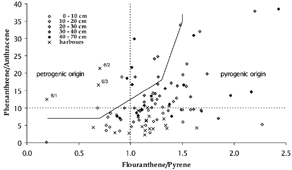
It can be seen that the upper layers and the harbor sediments are separated in a group according to the first principal component (PCA1) which explains 49% of the total variance. This indicates similar sources for these sediments. Consistent with the second principal component (PCA2) which explained 13% of the total variance, the samples collected in the Keszthely Bay (N1, S1, harbor 1) can be differentiated in a different cluster. This means that the west compartment of the lake has another common source. Other chemometric method, a self-organizing map (SOM) technique was also used for assessment of the distribution of PAHs in sediment samples (Citation8). Similar results were found as for the PCA analysis; namely, the upper layers of the sediments and samples collected at the harbors could be classified in a cluster. This also confirms the assumption that there are additional sources in the pollution of harbor sediments along with the atmospheric deposition, specifically the anthropogenic effects of ships burning oils.
CONCLUSIONS
The objective of the research was to study the distribution patterns of PAHs and to calculate approximately the correlation of source-sink relationship. The determination of 13 PAHs was carried out on sediment samples collected at 27 sites at the Lake Balaton. Sediment samples were collected from the upper 10 cm to 70 cm depth. The dry mass ratio of the fine grain-size fraction (<0.063 mm) and the coarse sand sediments (0.063–500 mm) were analyzed. The average concentration of PAHs was found around 132 μg/kg dry weight (11–1734 μg/kg) for all sites and depth. The ratio of phenantrene/anthracene (PHE/AN) and fluoranthene/pyrene (FA/PY) indicated that most of the samples showed pyrogenic origin. The upper layer of the sediment was significantly more polluted than the deeper ones. ISQG values and the PEL were used to compare the results with other data. No concentrations of PAHs were found higher than either ISQG and PEL of samples collected inside of the lake, so the sediment has not been associated with adverse biological effects. Analysis of the harbor sediments revealed an elevated amount of contamination probably derived from the fuel of the ships. Principal component analysis (PCA) was performed on the PAH compositional data for 110 samples to estimate the distribution of PAHs in different compartments.
Acknowledgments
The authors gratefully acknowledge the financial support of the Hungarian National Science Foundation (OTKA 043220), and Balaton Secretariat of the Prime Minister's Office.
Notes
a Provisional; adoption of marine ISQG and PEL.
REFERENCES
- Jenkins , B. M. , Jones , A. D. , Turn , S. Q. and Williams , R. B. 1996 . Particle Concentrations, Gas-Particle Partitioning, and Species Intercorrelations for Polycyclic Aromatic Hydrocarbons (PAH) Emitted During Biomass Burning . Atmos. Environ. , 30 : 3825 – 3835 .
- Verrhiest , G. J. , Clément , B. , Volat , B. , Montuelle , B. and Perrodin , Y. 2002 . Interactions Between Polycyclic Aromatic Hydrocarbon Mixture and the Microbial Communities in a Natural Freshwater Sediment . Chemosphere , 46 : 187 – 196 .
- Rose , N. L. and Rippey , B. 2002 . The Historical Record of PAH, PCB, Trace Metal and Fly Ash Particle Deposition at a Remote Lake in North-West Scotland . Environ. Pollution , 117 : 121 – 132 .
- Brenner , R. C. , Magar , V. S. , Ickes , J. A. , Abott , J. A. , Stout , S. C. , Crecilius , E. A. and Bingler , L. S. 2002 . Characterization and Fate of PAH-Contaminated Sediments at the Wyckoff/Eagle Harbor Superfund Site . Environ. Sci. Technol. , 36 : 2605 – 2613 .
- Wang , X. , Zhang , Y. and Chen , R. F. 2001 . Distribution and Partitioning of Polycyclic Aromatic Hydrocarbons (PAHs) in Different Size Fractions in Sediments from Boston Harbor, United States . Marine Pollution Bulletin , 42 : 1139 – 1149 . http://dx.doi.org/10.1016/S0025-326X%2801%2900129-1
- Su , M. , Christiansen , E. R. and Karls , J. F. 1998 . Determination of PAH Sources in Dated Sediments from Green Bay, Wisconsin, by Chemical Mass Balance Model . Environmental Pollutions , 98 : 411 – 419 .
- Li , K. , Christiansen , E. R. , Van Camp , R. P. and Imamoglu , I. 2001 . PAHs Dated Sediments of Ashtabula River, Ohio, USA . Environ. Sci. Technol. , 35 : 2896 – 2902 .
- Bodnár , E. , Abonyi , J. and Hlavay , J. 2003 . The Budget of Polycyclic Aromatic Hydrocarbons (PAHs) of the Lake Balaton . Proceeding of ISPAC 19 , : 196
- Baranyai , S . 1980 . “ Research and Regulation of the Lake Balaton ” . In Publications of Research Institute for Water Management , Budapest : Vituki .
- Kiss , G. , Gelencsér , A. , Krivácsy , Z. and Hlavay , J. 1997 . Occurrence and Determination of Organic Pollutants in Aerosol, Precipitation, and Sediment Samples Collected at Lake Balaton . J. Chromatogr. , A774 : 349 – 361 .
- Kiss , G. , Varga-Puchony , Z. and Hlavay , J. 1996 . Determination of Polycyclic Aromatic Hydrocarbons in Precipitation Using Solid Phase Extraction and Column Liquid Chromatography . J. Chromatogr. , A725 : 261 – 272 .
- Baumard , P. , Budzinski , H. , Garrigues , P. , Dizer , H. and Hansen , P. D. 1999 . Polycyclic Aromatic Hydrocarbons in Recent Sediments and Mussels (Mytilus edulis) from the Western Baltic Sea: Occurrence, Bioavailability and Seasonal Variations . Marine Environmental Research , 47 : 17 – 47 .
- Macías-Zamora , J. V. , Mendoza-Vega , E. and Villaescusa-Celaya , J. A. 2002 . PAHs Composition of Surface Marine Sediments: A Comparison to Potential Local Ssources in Todos Santos Bay, B.C., Mexico . Chemosphere , 46 : 459 – 468 . http://dx.doi.org/10.1016/S0045-6535%2801%2900069-8
- Budzinski , H. , Jones , I. , Bellocq , J. , Piérard , C. and Garrigues , P. 1997 . Evaluation of Sediment Contamination by Polycyclic Aromatic Hydrocarbons in the Gironde Estuary . Marine Chemistry , 58 : 85 – 97 .
- Cserny , T. , Földvári , M. , Ikrényi , K. , Bodor , E. and Hajós , M. 1991 . Geological Investigations of the Lacustrine Sediments of the Lake Balaton Based on Borehole tó 24 , Budapest : Hungarian Geological Institute .
- Arzayus , K. M. , Dickhut , R. M. and Canuel , E. A. 2001 . Fate of Atmospherically Deposited Polycyclic Aromatic Hydrocarbons (PAHs) in Chesapeake Bay . Environ. Sci. Technol. , 35 : 2178 – 2183 .
- Canadian Council of Ministers of the Environment . 1999 . Canadian Environmental Quality Guidelines, Winnipeg, MB: CCME. Fact Sheet 2: Chemical-Specific Sediment Quality Guideline
